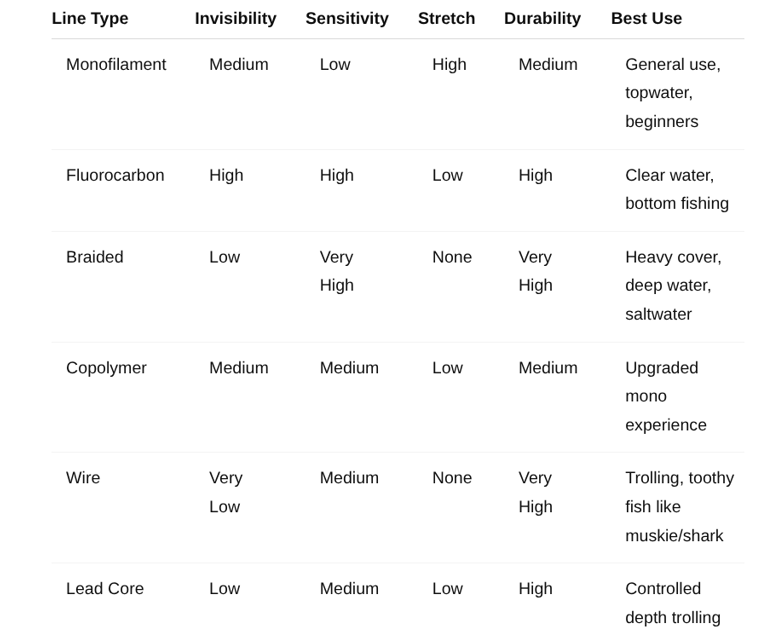The Different Types of Fishing Line: Choosing the Right One for Your Next Catch
Learn about the different types of fishing line—mono, fluoro, braid & more. Compare strengths, weaknesses & find the best line for your fishing style.
FISHING LINE
7/12/20254 min read


If you’ve ever stood in the fishing aisle staring at spools of line wondering what the difference is between all the options, you’re not alone. Fishing line comes in several different types, each with unique materials, strengths, and best-use scenarios. Whether you’re brand new to fishing or an experienced angler looking to refine your setup, knowing the right type of line can mean the difference between a great day on the water or the story of the one that got away.
A Complete Guide to Fishing Line Types and When to Use Each
In this guide, we’ll break down the major types of fishing lines—monofilament, fluorocarbon, braided, copolymer, wire, and lead core—along with their pros, cons, and when to use them. We’ll also provide a handy visual chart to help you quickly compare the options.
Monofilament Line
Material: Single strand of nylon
Monofilament—often called "mono"—is the most commonly used fishing line, especially for beginners. It’s affordable, easy to handle, and comes in various strengths and colors. One of the biggest advantages of mono is its stretch, which acts as a shock absorber during a fight with a fish. This stretch can help prevent your line from snapping if a fish makes a sudden run.
Strengths:
Budget-friendly
Good shock absorption
Easy to tie knots
Floats on water (ideal for topwater lures)
Drawbacks:
More line memory (it coils and holds its shape on the spool)
Degrades over time, especially with UV exposure
Less sensitive due to stretch
Best For:
Beginners
Topwater fishing
General-purpose freshwater setups
Fluorocarbon Line
Material: Fluoropolymer (a type of dense plastic)
Fluorocarbon is often favored for its invisibility underwater. It has a refractive index close to that of water, making it nearly invisible to fish. It also sinks, making it ideal for subsurface presentations. Because it's denser, fluoro is more sensitive and abrasion-resistant than mono, but also stiffer.
Strengths:
Virtually invisible underwater
High abrasion resistance
Sinks quickly
Low stretch for better sensitivity
Drawbacks:
More expensive than mono
Stiffer and harder to manage
Knots can be harder to tie correctly
Best For:
Clear water fishing
Bottom presentations (e.g., soft plastics, jigs)
Leaders when using braided main line
Braided Line
Material: Woven strands of synthetic fibers like Spectra or Dyneema
Braided line is known for its incredible strength-to-diameter ratio. It has no stretch, which makes it extremely sensitive—you’ll feel every bump, twitch, and nibble. Braided line casts further than mono or fluoro and lasts a long time without breaking down.
Strengths:
No stretch (great sensitivity)
Very strong and durable
Thin diameter for its strength
Long casting distance
Drawbacks:
Highly visible in water
Slippery (requires special knots or backing)
Can damage guides if they’re not braid-rated
Best For:
Heavy cover fishing
Deep water jigging
Saltwater applications
Fishing with spinning or baitcasting reels
Copolymer Line
Material: Blend of two or more nylon polymers
Copolymer line is essentially an upgraded monofilament. It’s smoother, stronger, and often has less memory than traditional mono. It offers a middle ground between mono and fluoro, combining ease of use with better sensitivity and abrasion resistance.
Strengths:
Stronger than mono
Less line memory
Good abrasion resistance
More manageable than fluoro
Drawbacks:
Slightly more expensive than mono
Not as invisible as fluoro
Best For:
Anglers who want mono-like handling with better performance
All-purpose fishing
Wire Line
Material: Stainless steel or titanium
Wire line is rarely used by beginners, but it plays an essential role in certain fishing conditions. It's incredibly durable and perfect for catching toothy fish like pike, muskie, or large saltwater predators. Most anglers use it for trolling or as a short leader.
Strengths:
Ultra-strong
Bite-proof for species with sharp teeth
Drawbacks:
Stiff and hard to work with
Requires special crimps or knots
Best For:
Trolling
Muskie, pike, or shark fishing
Leaders in saltwater setups
Lead Core Line
Material: Nylon outer sheath with a lead core
Lead core line is specialized gear for trolling at specific depths. By using different color-coded segments, anglers can estimate the depth based on how much line is out. It’s not something most bank anglers will ever use, but for serious lake or offshore trolling, it’s a must.
Strengths:
Allows precise depth control when trolling
Drawbacks:
Very thick and heavy
Limited casting ability
Best For:
Deep water trolling
Targeting lake trout, walleye, or salmon
Quick Comparison Chart


Choosing the Best Fishing Line for You
Choosing the right fishing line isn’t just about picking the strongest option—it’s about choosing the right line for your style, species, and water conditions. Here are a few tips to help you decide:
If You're a Beginner
Start with monofilament. It's easy to handle, affordable, and forgiving when you're learning to cast or tie knots.
If You Fish in Clear Water
Use fluorocarbon for its near-invisibility. Fish are more line-shy in clear lakes and streams.
If You Fish Heavy Cover
Go with braided line. The strength and abrasion resistance help you pull fish out of dense vegetation or around structure.
If You Want to Cast Far
Braided line’s thin diameter gives you an edge in casting distance.
If You Troll in Deep Water
Consider using lead core line to get your bait to the right depth without adding heavy sinkers.
If You’re Fishing for Sharp-Toothed Species
Use wire leaders or wire line to avoid losing gear to powerful bites.
Fishing line is one of the most important pieces of gear in your tackle box. Choosing the right type can drastically improve your success on the water. Whether you’re throwing top water lures for bass, jigging deep for walleye, or trolling for lake trout, there’s a line built for the job.
Hopefully, this guide clears up some of the confusion and helps you make a more informed choice next time you spool up your reel. Tight lines!

